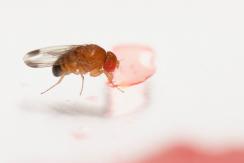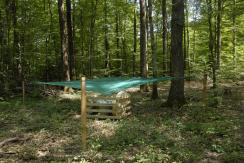Evolutionary Ecology
The department of Evolutionary Ecology gathers complementary skills in behavioural ecology, population dynamics, population biology, community ecology, and methodology (statistics and modelling). The research done in the department aims at studying how animal species evolve in a changing world by understanding the causes of the evolution of traits, adaptations and interactions. For that, we consider different levels of organization from individuals to populations and communities. Because organisms cannot be considered isolated from other biotic factors, we consider pathogens but also competing species within communities.
We study how individuals adapt to their environments that are largely impacted by anthropic pressures, and how life history traits and behaviour evolve in response to these pressures. Although we mainly focus on phenotype, we more and more consider the mechanistic link between the genotype and the phenotype. We develop the theoretical framework of our discipline through a conceptual and modeling approach. In parallel, we test hypotheses that arise from theoretical predictions through experimental, comparative and observational approaches on different biological models (insects, birds, mammals). Experimental approaches are developed in the laboratory (insect model) and in natura (bird, insect and mammal models). Observational and comparative research is mainly concerned with vertebrates. Our approaches are also, and increasingly, interested in the mechanisms of adaptive responses. In addition to the classical approaches of demographic analysis and trait change, methods of ecophysiology, chemical ecology and molecular biology are used.
Our department hosts several long-term studies of wild populations of different species. These long-term studies offer a valuable way to understand how biotic and abiotic factors affect individuals’ life history traits, and the functioning of populations in natura. Five populations of mammalian species are thus monitored for several years (more than 40 years on roe deer, 30 on Alpine marmots, 25 years on cats, 16 years on zebras, and 20 years on impala). Two of our study sites (La Sassière in Vanoise National Park (Alpine marmots) and Hwange National Park) have been certified as “Site d’Etude en Ecologie Globale” (SEEG), and two (ZA “Hwange” and ZA “Antarctic and sub-Antarctic”) were certified as “Zone Atelier” by the CNRS.
The department of Evolutionary ecology is also largely involved in training activities. Lastly, we also have strong socio-economic relationships. Indeed, because we address questions of major societal interest (global warming, public health) we tightly collaborate with socio-economic partners (Office Français de la Biodiversité, Vanoise National Park, Hwange National Park in Zimbabwe, Office National des Forêts, etc.) and participate to general public and media events.
Publications
Display of 391 to 420 publications on 2449 in total
Structure génétique et morphométrie crânienne dans le genre Arvicola
Arvicola . ( Actes des 2èmes Rencontres Nationales Petits Mammifères ) : 108-117
Journal article
see the publicationInterbacterial Transfer of Carbapenem Resistance and Large Antibiotic Resistance Islands by Natural Transformation in Pathogenic Acinetobacter
mBio . 13 ( 1 ) : e02631-21
Journal article
see the publicationIntegrative Phylogenetics: Tools for Palaeontologists to Explore the Tree of Life
Biology . 11 ( 8 ) : 1185
Journal article
see the publicationA review of modelling approaches for ecological risk assessment of pesticides
SETAC Europe 32nd annual meeting .
Poster
see the publicationUnravelling the environmental correlates influencing the seasonal biodiversity of aquatic Heteropteran assemblages in northern Africa
Limnologica . : 126021
Journal article
see the publicationImpacts des produits phytopharmaceutiques sur la biodiversité et les services écosystémiques. Rapport de l’expertise scientifique collective
: 1408 p.
DOI: 10.17180/0gp2-cd65
Report
see the publicationCompensatory recruitment allows amphibian population persistence in anthropogenic habitats
Proceedings of the National Academy of Sciences of the United States of America . 119 ( 38 ) : e2206805119
Journal article
see the publicationPrevalence of major digestive and respiratory helminths in dogs and cats in France: results of a multicenter study
Parasites & Vectors . 15
Journal article
see the publicationEditorial: Advances in Statistical Ecology: New Methods and Software
Frontiers in Ecology and Evolution . 9
Journal article
see the publicationInterpretation of the results of Q fever ELISA tests in domestic ruminants : a user-friendly Shiny appli-cation based on latent class models in a Bayesian framework
ESCCAR International congress on Rickettsiae and 9th Meeting of the European Society for Chlamydia Research (ESCR) .
Conference paper
see the publicationImpacts des produits phytopharmaceutiques sur la biodiversité et les services écosystémiques. Synthèse de l’expertise scientifique collective
: 136 p.
DOI: 10.17180/gfkj-e861
Report
see the publicationUpper upper Albian (Mortoniceras rostratum Zone) cephalopods from Clansayes (Drôme, south-eastern France).
Acta Geologica Polonica . 72 ( 2 ) : 187-233
Journal article
see the publicationEvaluation using latent class models of the diagnostic performances of three ELISA tests commercialized for the serological diagnosis of Coxiella burnetii infection in domestic ruminants
ESCCAR International congress on Rickettsiae and 9th Meeting of the European Society for Chlamydia Research (ESCR) . : #231
Poster
see the publicationCoxiella burnetii within- and between-herd true seroprevalence assessment in domestic ruminants in France accounting for diagnostic uncertainty with latent class
ESCCAR International congress on Rickettsiae and 9th Meeting of the European Society for Chlamydia Research (ESCR) . : #232
Poster
see the publicationTelomeres as a sentinel of population decline in the context of global warming
Proceedings of the National Academy of Sciences of the United States of America . 119 ( 35 )
Journal article
see the publicationFAIR data pipeline: provenance-driven data management for traceable scientific workflows
Philosophical Transactions of the Royal Society A: Mathematical, Physical and Engineering Sciences . 380 ( 2233 ) : 20210300
Journal article
see the publicationComplex model calibration through emulation, a worked example for a stochastic epidemic model
Epidemics . 39 : 100574
Journal article
see the publicationExact Bayesian inference of epidemiological parameters from mortality data: application to African swine fever virus
Journal of the Royal Society Interface . 19 ( 188 )
Journal article
see the publicationSpecies-Specific Molecular Barriers to SARS-CoV-2 Replication in Bat Cells
Journal of Virology . 96 ( 14 )
DOI: 10.1128/jvi.00608-22
Journal article
see the publicationDeciphering the morphological variation and its ontogenetic dynamics in the Late Devonian conodont Icriodus alternatus
Fossil Record . 25 ( 1 ) : 25-41
DOI: 10.3897/fr.25.80211
Journal article
see the publicationNew perspectives on the calculation of bioaccumulation metrics for active substances in living organisms
Integrated Environmental Assessment and Management . 18 : 10-18
Journal article
see the publicationHarvesting can stabilise population fluctuations and buffer the impacts of extreme climatic events
Ecology Letters . 25 ( 4 ) : 863-875
DOI: 10.1111/ele.13963
Journal article
see the publicationDNA methylation as a tool to explore ageing in wild roe deer populations
Molecular Ecology Resources . 22 ( 3 ) : 1002-1015
Journal article
see the publicationAn appraisal of graph embeddings for comparing trophic network architectures
Methods in Ecology and Evolution . 13 ( 1 ) : 203-216
Journal article
see the publicationCo-variation between glucocorticoids, behaviour and immunity supports the pace-of-life syndrome hypothesis: an experimental approach
Proceedings of the Royal Society B: Biological Sciences . 289 ( 1975 ) : 20220464
Journal article
see the publicationVariations in immune parameters with age in a wild rodent population and links with survival
Ecology and Evolution . 12 ( 7 ) : e9094
DOI: 10.1002/ece3.9094
Journal article
see the publicationDoes mast seeding shape mating time in wild boar? A comparative study
Biology Letters . 18 ( 7 )
Journal article
see the publicationMacroecological patterns of fruit infestation rates by the invasive fly Drosophila suzukii in the wild reservoir host plant Sambucus nigra
Agricultural and Forest Entomology . 24 ( 4 ) : 548-563
DOI: 10.1111/afe.12520
Journal article
see the publicationA critical review of effect modeling for ecological risk assessment of plant protection products
Environmental Science and Pollution Research . 29 : 43448-43500
Journal article
see the publication





You also, comment on this article